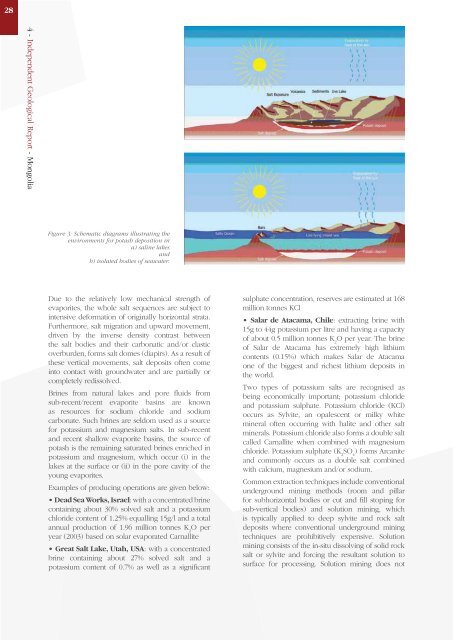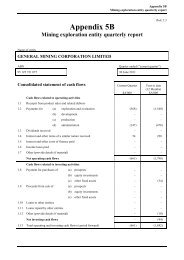Mongolia - General Mining
Mongolia - General Mining
Mongolia - General Mining
Create successful ePaper yourself
Turn your PDF publications into a flip-book with our unique Google optimized e-Paper software.
28<br />
4 - Independent Geological Report - <strong>Mongolia</strong><br />
Figure 3: Schematic diagrams illustrating the<br />
environments for potash deposition in<br />
a) saline lakes<br />
and<br />
b) isolated bodies of seawater.<br />
Due to the relatively low mechanical strength of<br />
evaporites, the whole salt sequences are subject to<br />
intensive deformation of originally horizontal strata.<br />
Furthermore, salt migration and upward movement,<br />
driven by the inverse density contrast between<br />
the salt bodies and their carbonatic and/or clastic<br />
overburden, forms salt domes (diapirs). As a result of<br />
these vertical movements, salt deposits often come<br />
into contact with groundwater and are partially or<br />
completely redissolved.<br />
Brines from natural lakes and pore fluids from<br />
sub-recent/recent evaporite basins are known<br />
as resources for sodium chloride and sodium<br />
carbonate. Such brines are seldom used as a source<br />
for potassium and magnesium salts. In sub-recent<br />
and recent shallow evaporite basins, the source of<br />
potash is the remaining saturated brines enriched in<br />
potassium and magnesium, which occur (i) in the<br />
lakes at the surface or (ii) in the pore cavity of the<br />
young evaporites.<br />
Examples of producing operations are given below:<br />
• Dead Sea Works, Israel: with a concentrated brine<br />
containing about 30% solved salt and a potassium<br />
chloride content of 1.25% equalling 15g/l and a total<br />
annual production of 1.96 million tonnes K O per 2<br />
year (2003) based on solar evaporated Carnallite<br />
• Great Salt Lake, Utah, USA: with a concentrated<br />
brine containing about 27% solved salt and a<br />
potassium content of 0.7% as well as a significant<br />
sulphate concentration, reserves are estimated at 168<br />
million tonnes KCl<br />
• Salar de Atacama, Chile: extracting brine with<br />
15g to 44g potassium per litre and having a capacity<br />
of about 0.5 million tonnes K O per year. The brine<br />
2<br />
of Salar de Atacama has extremely high lithium<br />
contents (0.15%) which makes Salar de Atacama<br />
one of the biggest and richest lithium deposits in<br />
the world.<br />
Two types of potassium salts are recognised as<br />
being economically important; potassium chloride<br />
and potassium sulphate. Potassium chloride (KCl)<br />
occurs as Sylvite, an opalescent or milky white<br />
mineral often occurring with halite and other salt<br />
minerals. Potassium chloride also forms a double salt<br />
called Carnallite when combined with magnesium<br />
chloride. Potassium sulphate (K SO ) forms Arcanite<br />
2 4<br />
and commonly occurs as a double salt combined<br />
with calcium, magnesium and/or sodium.<br />
Common extraction techniques include conventional<br />
underground mining methods (room and pillar<br />
for subhorizontal bodies or cut and fill stoping for<br />
sub-vertical bodies) and solution mining, which<br />
is typically applied to deep sylvite and rock salt<br />
deposits where conventional underground mining<br />
techniques are prohibitively expensive. Solution<br />
mining consists of the in-situ dissolving of solid rock<br />
salt or sylvite and forcing the resultant solution to<br />
surface for processing. Solution mining does not




